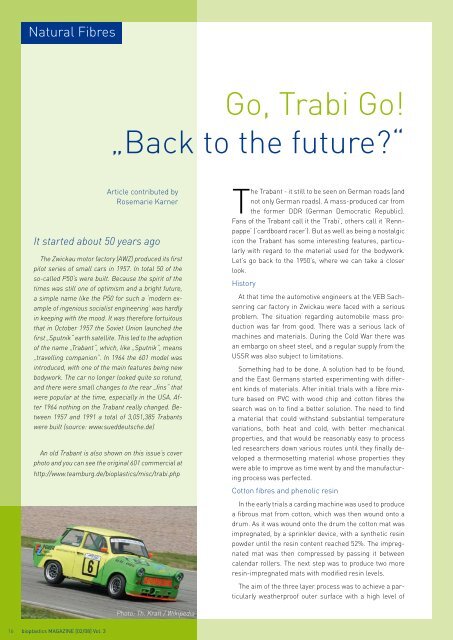02 | 2008
You also want an ePaper? Increase the reach of your titles
YUMPU automatically turns print PDFs into web optimized ePapers that Google loves.
Natural Fibres<br />
Go, Trabi Go!<br />
„Back to the future?“<br />
Article contributed by<br />
Rosemarie Karner<br />
It started about 50 years ago<br />
The Zwickau motor factory (AWZ) produced its first<br />
pilot series of small cars in 1957. In total 50 of the<br />
so-called P50‘s were built. Because the spirit of the<br />
times was still one of optimism and a bright future,<br />
a simple name like the P50 for such a ‘modern example<br />
of ingenious socialist engineering’ was hardly<br />
in keeping with the mood. It was therefore fortuitous<br />
that in October 1957 the Soviet Union launched the<br />
first „Sputnik“ earth satellite. This led to the adoption<br />
of the name „Trabant“, which, like „Sputnik“, means<br />
„travelling companion“. In 1964 the 601 model was<br />
introduced, with one of the main features being new<br />
bodywork. The car no longer looked quite so rotund,<br />
and there were small changes to the rear „fins“ that<br />
were popular at the time, especially in the USA. After<br />
1964 nothing on the Trabant really changed. Between<br />
1957 and 1991 a total of 3,051,385 Trabants<br />
were built (source: www.sueddeutsche.de)<br />
An old Trabant is also shown on this issue’s cover<br />
photo and you can see the original 601 commercial at<br />
http://www.teamburg.de/bioplastics/misc/trabi.php<br />
The Trabant - it still to be seen on German roads (and<br />
not only German roads). A mass-produced car from<br />
the former DDR (German Democratic Republic).<br />
Fans of the Trabant call it the ‘Trabi’, others call it ‘Rennpappe’<br />
(‘cardboard racer’). But as well as being a nostalgic<br />
icon the Trabant has some interesting features, particularly<br />
with regard to the material used for the bodywork.<br />
Let’s go back to the 1950‘s, where we can take a closer<br />
look.<br />
History<br />
At that time the automotive engineers at the VEB Sachsenring<br />
car factory in Zwickau were faced with a serious<br />
problem. The situation regarding automobile mass production<br />
was far from good. There was a serious lack of<br />
machines and materials. During the Cold War there was<br />
an embargo on sheet steel, and a regular supply from the<br />
USSR was also subject to limitations.<br />
Something had to be done. A solution had to be found,<br />
and the East Germans started experimenting with different<br />
kinds of materials. After initial trials with a fibre mixture<br />
based on PVC with wood chip and cotton fibres the<br />
search was on to find a better solution. The need to find<br />
a material that could withstand substantial temperature<br />
variations, both heat and cold, with better mechanical<br />
properties, and that would be reasonably easy to process<br />
led researchers down various routes until they finally developed<br />
a thermosetting material whose properties they<br />
were able to improve as time went by and the manufacturing<br />
process was perfected.<br />
Cotton fibres and phenolic resin<br />
In the early trials a carding machine was used to produce<br />
a fibrous mat from cotton, which was then wound onto a<br />
drum. As it was wound onto the drum the cotton mat was<br />
impregnated, by a sprinkler device, with a synthetic resin<br />
powder until the resin content reached 52%. The impregnated<br />
mat was then compressed by passing it between<br />
calendar rollers. The next step was to produce two more<br />
resin-impregnated mats with modified resin levels.<br />
The aim of the three layer process was to achieve a particularly<br />
weatherproof outer surface with a high level of<br />
Photo: Th. Kraft / Wikipedia<br />
16 bioplastics MAGAZINE [<strong>02</strong>/08] Vol. 3


















